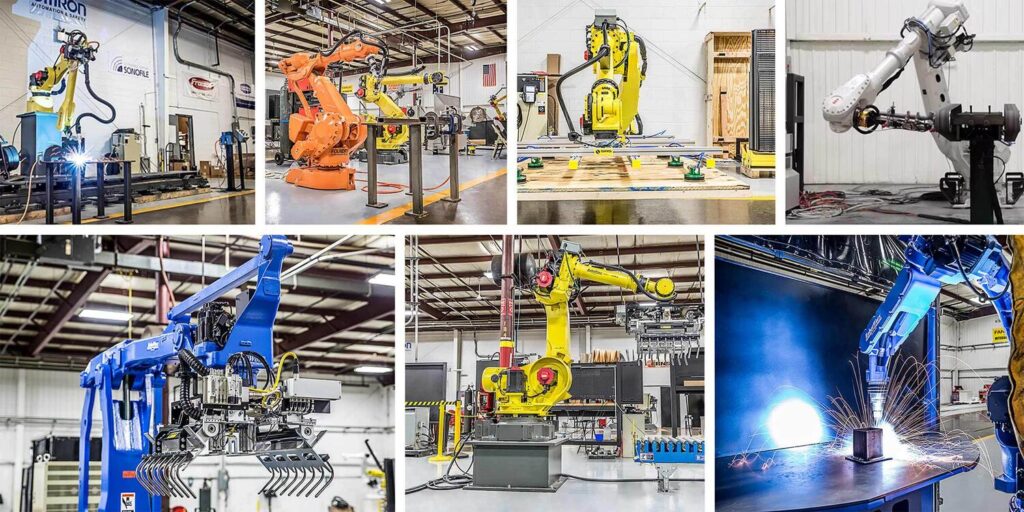
Controlling a Robot 101
“Motion control” also known as “servo control” or “robotics” is a subfield of automation that encompasses moving parts of robots in a controlled manner. Motion control systems typically include a motion controller, an energy amplifier (also known as a servo drive), and one or more prime movers or actuators. The type of actuator you need is based on several factors including power, speed, precision and budget.
There are three types of actuation technology used in motion control systems:
- Pneumatic
- Hydraulic
- Electromechanical
For this overview we will address the third in this series, electromechanical actuation technology which is what is found in industrial robots. Electromechanical systems are typically used in low power, high speed applications that require extreme precision. In this system the actuators used would be the robot’s motor. This type of system is known as a feedback system. Feedback systems use the input they receive to determine the output they produce. This feedback may be used to control the position, velocity, or acceleration of the motion your robot is doing. When you think of the feedback as a loop the controller is the device that manages all the machine interfacing and closes the loop which is typically the position or velocity of the robot’s action. The servo drive or also known as the amplifier, closes the inner loop and is the power that drives the motor according to the signals the controller puts out. The motor is the actuator in this system and generates the power or force needed to move the load.

Robotic Controller
The controller acts as a traffic controller in this example of the servo system. It is the controller’s job to generate the motion and react to any changes in it’s environment. A controller could be as simple as an on/off switch on a machine or a dial that the operator controls. For more complex robots and machines, a controller could be an actual computer that actively controls all the axis of the robot but also monitors the programming and I/O of the machine.
The controller is the “brains” of the servo by sending a signal to the drive, the drive will then provide power to the motor based on the signal of the controller. From here the “feedback” is sent back to the controller which allows the device to make corrections based on errors it receives and sends the signal back to the drive or amplifier.
Servo Drive
Servo drives are made up of circuit boards, wires, microchips and connectors. These drives are responsible for the motor’s movement and can make the motor accelerate, slow down, stop or even reverse at any given moment. The controller in this case would tell the drive what speed to increase or decrease. At this time the drive takes that signal and amplifies it to “translate” the controller’s signal into the voltage or current the motor requires. This signal is able to be amplified by the servo drive’s power source. This is typically either received from a battery or a device that plugs in to an outlet.
Drives originally started as their only function being to be the power stage that helped the controller to drive the motor. Today’s drives are able to take on more complex control functions that operators used to rely on the controller for.
Servo Motors
Coming to the final element of the feedback process is the servo motor. Once the motor receives the previously stated signals, it then converts those signals into a mechanical motion. This mechanical motion could be anything from raising a robotic arm at one of the robot’s axis to turning the tool by rotating the robot’s wrist or “J5”.
There are two different phases that many motors fall into. Single phase motors are easy to set up and have two power wires. These would include brush motors, linear actuators, magnetic bearings, and more. Three phase motors have higher power density and are typically used for more complex applications. These motors are typically more difficult to set up and include brushless or “rotary” motors as well as liner motors.
Load
The last piece of the motion control system is the load with which the robot or application is moving. The load sends feedback to the controller in two ways, either through absolute feedback, the exact position the load is at, or through relative feedback which only provides incremental updates on the loads position. While absolute feedback does not need relative feedback, relative feedback does need some form of absolute feedback in the form of a limit switch to help define the starting position of the load. Once the starting position is identified, relative feedback can provide position updates.
Hopefully this article has shed some light on the basics of motion control for you and how it works with your robot. For more advanced knowledge on understanding motion control or your new robot feel free to sign up for one of our training classes or contact our tech department.
Get your Fanuc CNC machine back up and running.
TIE offers same day shipping on more than 100,000 Fanuc CNC parts in stock. We offer a 1 year in service warranty on all parts and repairs.
Shop PartsWas this helpful?
2 / 0